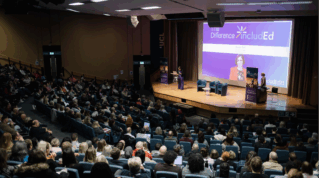For those of us who work around the impact of online disinformation, there’s been nothing bigger in terms of generating discussion around the impact of online content on young people than Adolescence.
Stephen Graham and co-creator Jack Thorne have spoken about their desire to portray a very normal family, and they do this well. Too often, though, there’s a thread that runs through this programme and through most depictions of young people impacted by conspiracy content: whatever else they may be, they’re usually male.
Our research for the Commission into Countering Online Conspiracies in Schools shows that actually the inverse is true. Girls are more vulnerable to conspiracy belief than boys.
To be clear: there are unquestionably forms of online disinformation content that appeal to young men. We heard in our focus groups about the influence of Andrew Tate, and it was a very real concern. But there is so much more out there than just the so-called manosphere.
For the past year, the Commission, funded by the Pears Foundation, has examined the impact of mis- and disinformation content in schools. We polled school staff, students and parents on the issue and conducted focus groups across the country. We believe this is the largest ever study into the impact of this content in school environments.
What we found offers an important challenge to many of the stereotypes around misinformation.
Firstly, we found that the most receptive demographic group to conspiracies wasn’t boys. It was girls, as well as younger siblings, and pupils eligible for free school meals. In the second phase of our research, we are attempting to uncover why this is the case.
And there’s another reason to think about the impact of this content on girls. We also found that conspiracy content has wider implications, aside from classroom behaviour.
Around one-third of pupils say that they have experienced a friendship becoming more difficult because of an opinion held by a friend, with girls more likely to report experiencing this than boys.
No demographic is immune, and no group is ‘the problem’
In one focus group I ran, a girl explained that Andrew Tate content had made it harder to keep friendships: “…I don’t speak to them [friends who had got into Tate content] anymore, for obvious reasons. But they were tunnel-vision with that mindset.”
The Commission’s evidence sessions warned of mental health harms linked with exposure to harmful content, including conspiracy‑adjacent material tapping into self-harm, suicide and eating disorders.
Schools cannot treat girls as passive bystanders in these harms. In many cases, they’re the ones most caught in the crossfire where conspiracy, anxiety, self‑image and peer pressure intersect.
So, should schools looking to tackle this issue pivot, and focus on girls?
Well, yes and no.
We should be far more open to the idea that girls are impacted by online mis- and disinformation. We absolutely should be thinking about the knock-on impact on social bonds and self-esteem when it comes to girls.
But most importantly, we also found that demographics are the wrong place to be looking. Psychological factors are more closely linked to how students approach conspiracies and therefore are better predictors.
Marginalisation (the feeling that the world has been set up in ways that discriminate against the respondent) had the strongest link with receptiveness to conspiracy belief of all the variables we tested.
The wider issue of misinformation is a cross-societal one. In our focus groups with parents, participants revealed conspiracy belief quite casually: “I mean, I’m open to them looking at conspiracy theories and talking about it, because my husband believes 9/11 was a conspiracy…”
It’s easy to just focus on a single demographic. It’s reassuring to think that interventions can be targeted or that the real problem is somewhere else.
But the fundamental issue of combatting misinformation and conspiracies is only going to get more important, and to have real impact, we need a whole-school approach.
No demographic is immune, and no group of pupils is ‘the problem’.
The problem is in all of us.
This is the first in a new series exclusive to Schools Week from the Pears Foundation’s Commission into Countering Online Conspiracies in Schools. Read them all here as they appear











Your thoughts